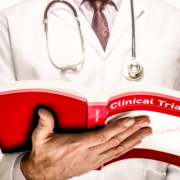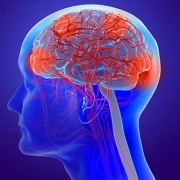Cortical-Striatal Disconnection After Parietal Stroke
By Dr Barbara Casolla, MD, Univ. Lille, Inserm U1171, Degenerative and Vascular Cognitive Disorders, CHU Lille, Department of Neurology, France
Twitter: @BarbaraCasolla
Clinical vignette
An 82 years old patient was referred to the Emergency Department for a sudden left hemiparesis associated with dysarthria. His past history and vascular risk factors included a triple aorto-coronary bypass, arterial hypertension and dyslipidemia under medical treatment.
On admission, the patient was agitated and the neurological examination showed severe dysarthria, left central facial palsy, left homonymous hemianopia, a motor deficit of the upper left limb, discrete sensory deficits on the left hemibody and tactile hemi-extinction (without position sense impairment). NIH Stroke Scale was 10. An MRI was performed at the emergency department (figure 1).
The patient underwent iv thrombolysis. About 6 hours later, the patient presented with an acute-onset movement disorder (video). We performed a new MRI that showed neither new ischemic lesion nor haemorrhagic transformation. The basal ganglia, thalamus, and subthalamic region were intact.
The patient underwent iv thrombolysis. About 6 hours later, the patient presented with an acute-onset movement disorder (video). We performed a new MRI that showed neither new ischemic lesion nor haemorrhagic transformation. The basal ganglia, thalamus, and subthalamic region were intact.
Video: Left hemiballism. Ballism is a hyperkinetic movement disorder, characterized by brisk, fast, flinging and unpredictable high amplitude movement. The movement has some element of rotation and occurs mainly in the proximal segment of the limbs. Its differential diagnosis involves the more common pseudo-choreoathetosis, which results from proprioceptive sensation deficit and appears as a snake-like, principally confined to the distal extremity.
How do you define the movement disorder? Which is the physiopathology? Where is the culprit cerebral lesion? How do you treat it?
Ballism in cerebrovascular diseases
The frequency of post-stroke movement disorders varies from 1% to 4% of all strokes, with both sexes equally affected 1,2,3. Mean age at onset is typically 60-70 years, but extreme ages can be also affected3. Onset and progression of post-stroke movement disorder is variable, because they can occur immediately at the onset of the acute stroke, or they can be delayed and progressive. Hemiballism showed a prevalence of 0.4%. It is often preceded by hemiparesis and has been described during acute stroke presentation or shortly after2. Although various structural lesions have been associated with ballism5, damage to the subthalamic nucleus and the pallidosubthalamic pathways appear to play a critical role in its expression. Nevertheless, this anatomical correlation may extend beyond the contralateral subthalamic nucleus, through connecting structures to the adjacent internal capsule. In particular, anterior parietal strokes, without any evidence of involvement of the basal ganglia, thalamus or subthalamic nucleus, have been associated with contralateral hemiballism5. In these cases, the pathophysiologic mechanisms implicate the interruption of the parieto-striatal pathways. Indeed, under normal physiologic conditions, the cerebral cortex provides excitatory stimuli to the basal ganglia; thus, lesions involving cortico-striatal fibers may disrupt the balance of basal ganglia circuits.
Treatments
Although usually self-limited, post-stroke ballism can substantially increase morbidity through injury (rhabdomyolysis is a very frequent complication) and impaired coordination. Pharmacological therapy consists of antidopaminergic therapy with neuroleptics, through the block of dopamine receptors. These drugs may cause parkinsonism and tardive dyskinesia. Indeed, tetrabenazine, a dopamine-depleting agent, has become the preferred choice because it does not cause tardive dyskinesia. Clonazepam and sodium valproate have also been used with some success7. In a small case series, complete improvement was reported in 45–56% on one or two of these drugs2,8. Compared with conditions that result from destruction of the subthalamic nucleus, our patient’s hemiballismus was milder and was successfully treated with tetrabenazine.
Acknowledgments:
Dr Alexandre Kreisler, CHRU Lille, France
References
- Mehanna R. and Jankovic J. Movement disorders in cerebrovascular diseases. Lancet Neurol 2013; 12: 597–608.
- Ghika-Schmid F, Ghika J, Regli F, Bogousslavsky J. Hyperkinetic movement disorders during and after acute stroke: the Lausanne stroke registry. J Neurol Sci 1997; 146: 109–16.
- Alarcon F, Zijlmans JC, Duenas G, Cevallos N. Post-stroke movement disorders: report of 56 patients. J Neurol Neurosurg Psychiatry 2004; 75: 1568–74.
- Postuma RB, Lang AE. Hemiballism: revisiting a classic disorder. Lancet Neurol 2003; 2: 661–68.
- Rossetti AO, Ghika JA, Vingerhoets F, Novy J, Bogousslavsky J. Neurogenic pain and abnormal movements contralateral to an anterior parietal artery stroke. Arch Neurol 2003; 60: 1004–06.
- Young AB, Penney JB. Neurochemical anatomy of movement disorders. Neurol Clin. 1984;2:417-433.
- Shannon KM. Hemiballismus. Curr Treat Options Neurol 2005; 7: 203–10.
- Ristic A, Marinkovic J, Dragasevic N, Stanisavljevic D, Kostic V. Long-term prognosis of vascular hemiballismus. Stroke 2002; 33: 2109–11.




